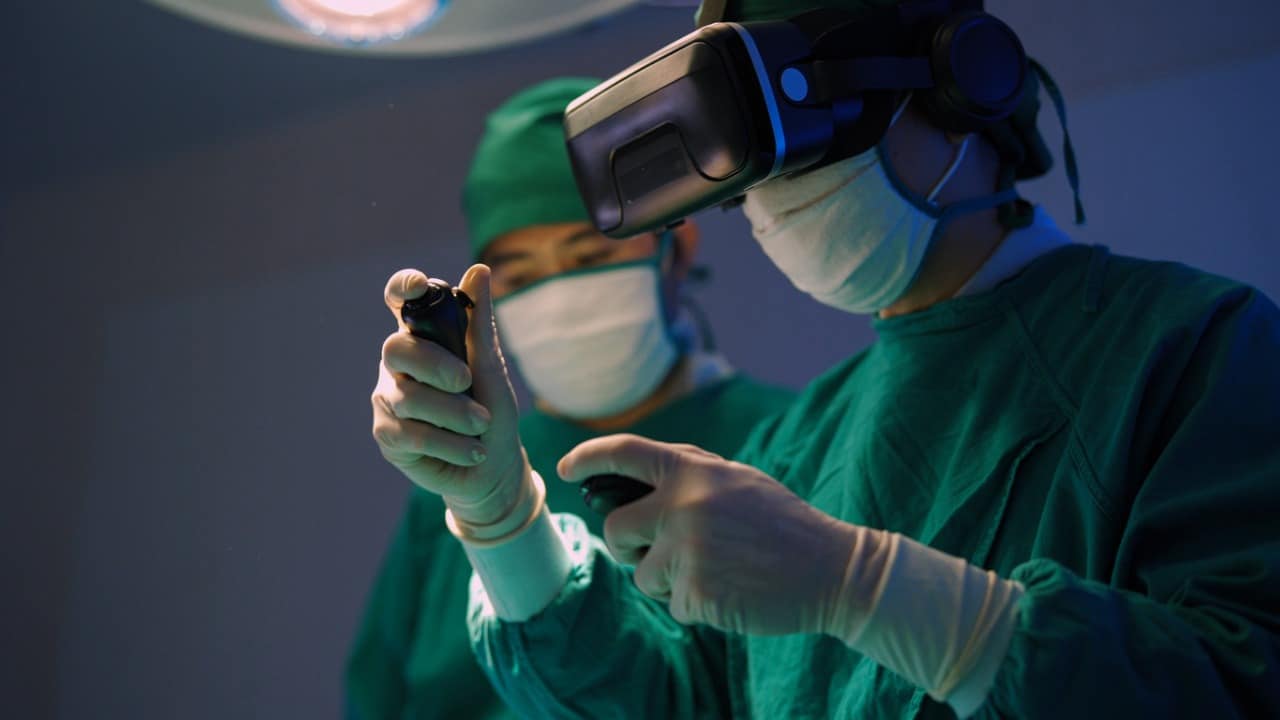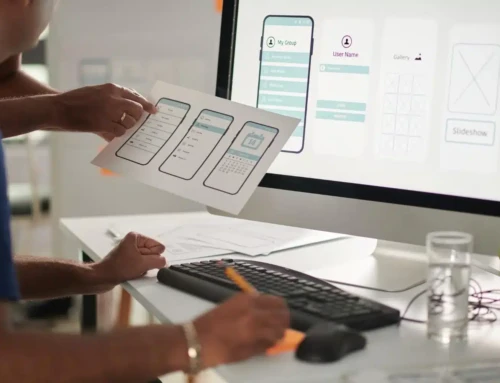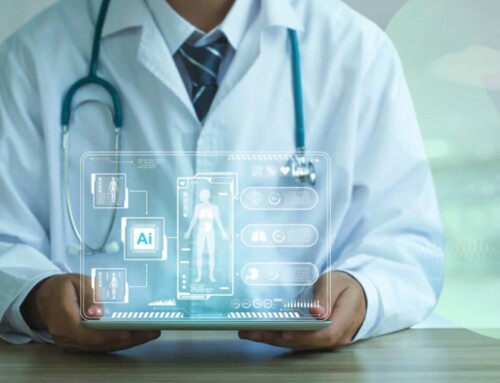Welcome to the captivating realm of Virtual Reality (VR) and Augmented Reality (AR) in medical apps, a landscape where innovation intersects with healthcare. This exploration delves into the transformative potential of these immersive technologies in the medical field.
This discourse uncovers the revolutionary impact of VR and AR in medical applications, highlighting the focus on groundbreaking advancements. The dynamic convergence of VR and AR in healthcare has led to innovative medical apps that revolutionize patient care, medical training, and treatment procedures. This article adheres to SEO best practices to ensure information reaches the right audience and sparks imagination.
Embark with us into the world of medical apps empowered by VR and AR, where reality and imagination merge, shaping the future of healthcare.
Understanding Virtual Reality (VR) and Augmented Reality (AR)
At the core of this digital revolution lie two immersive technologies: Virtual Reality (VR) and Augmented Reality (AR). Though similar in their ability to alter perception and enhance experiences, they are distinct in their approach.
Virtual Reality (VR) transports users to entirely new simulated environments, disconnecting them from the physical world. Users wear VR headsets that immerse them in computer-generated environments, enabling them to interact and navigate through 3D spaces.
On the other hand, Augmented Reality (AR) overlays digital content onto the real world, allowing users to interact with both physical and digital elements simultaneously. AR is often experienced through mobile devices or smart glasses, seamlessly blending computer-generated graphics into the user’s real-world surroundings.
In medical applications, VR and AR redefine the boundaries of training, education, and patient care. VR creates realistic simulations for medical training, enabling surgeons to practice complex procedures and medical students to learn in a risk-free environment. AR, on the other hand, provides real-time data and visual aids during surgeries and assists healthcare professionals in making accurate diagnoses.
The promise of VR and AR in healthcare lies not only in their ability to educate and train but also in their potential to enhance patient outcomes. By immersing patients in calming VR environments during medical procedures or using AR to visualize treatment plans, medical apps powered by these technologies have the potential to revolutionize patient care.
As we venture deeper into the vast potential of VR and AR in medical apps, we are reminded of the transformative possibilities that await in the realm of healthcare technology.
The Promise of VR and AR in Healthcare
In the ever-evolving landscape of healthcare, Virtual Reality (VR) and Augmented Reality (AR) offer a wealth of promises that transcend the boundaries of traditional medical practices. These immersive technologies open a realm of possibilities across various medical fields, transforming the way healthcare professionals learn, treat, and interact with patients.
Medical Training and Education
The integration of VR and AR in medical training and education marks a paradigm shift. Aspiring surgeons can undergo realistic simulations of complex surgeries, enabling them to refine their skills in a controlled environment without risk to patients. Medical students can explore detailed anatomical structures, enhancing their understanding of human anatomy in a way that textbooks cannot match. Such immersive learning experiences equip medical professionals with invaluable expertise and confidence as they step into the real world of patient care.
Enhanced Patient Care and Treatment
VR and AR revolutionize patient care by empowering healthcare professionals with augmented information in real-time. Surgeons can access patient data and visualize critical details during procedures, improving precision and efficiency. AR-guided surgeries allow for precise navigation and better visualization of anatomical structures, leading to safer and more successful outcomes. VR also plays a crucial role in managing chronic pain, anxiety, and post-traumatic stress disorders by immersing patients in calming environments, reducing reliance on medication.
Therapeutic Applications
Beyond training and treatment, VR and AR offer therapeutic benefits in patient rehabilitation. Immersive VR environments can aid in physical therapy and neurorehabilitation, motivating patients to engage in repetitive exercises. AR-based solutions enable patients to perform daily tasks with augmented assistance, fostering independence and enhancing their quality of life.
Medical Research and Data Visualization
VR and AR are invaluable tools for medical research and data visualization. Researchers can explore complex data sets in three-dimensional space, facilitating a deeper understanding of biological processes and disease progression. These technologies also enable medical professionals to collaborate remotely, bridging geographical gaps and sharing insights seamlessly.
The boundless potential of VR and AR in healthcare drives our journey through the realms of medical apps. Developmental progress guides us towards a future where technology and compassion converge for the benefit of patients and medical professionals alike.
Medical Apps Revolution: Incorporating VR and AR
The revolution in medical apps powered by VR and AR is rapidly unfolding, paving the way for groundbreaking solutions that redefine patient care and healthcare practices.
Surgical Simulations and Training
VR-based surgical simulators provide a safe environment for surgeons to practice intricate procedures with haptic feedback, replicating the tactile sensations of real surgeries. These simulations contribute to improved surgical proficiency and reduced errors, ultimately benefiting patients.
Patient-Focused Treatment Planning
AR-driven medical apps assist healthcare professionals in planning treatments tailored to individual patients. By overlaying digital data onto patient anatomy, surgeons gain real-time insights during procedures, enhancing accuracy and decision-making.
Medical Imaging and Visualization
VR and AR technologies enhance the visualization of medical imaging data, empowering radiologists and physicians to explore 3D models of anatomical structures. This enhanced understanding facilitates accurate diagnoses and personalized treatment plans.
Pain Management and Rehabilitation
VR-based medical apps offer therapeutic experiences to manage pain and promote rehabilitation. Virtual environments distract patients from discomfort during medical procedures, while immersive AR-based rehabilitation apps motivate patients to engage in therapy exercises.
Remote Consultations and Telementoring
VR and AR enable medical professionals to conduct remote consultations and telementoring sessions, facilitating collaboration and knowledge exchange across geographical barriers. This fosters a global network of expertise in healthcare.
Mental Health Interventions
VR-based exposure therapy proves beneficial for treating phobias, anxiety disorders, and post-traumatic stress disorder. These immersive experiences gradually desensitize patients to triggers, supporting their journey towards recovery.
In this burgeoning era of medical apps, the fusion of VR and AR is revolutionizing healthcare practices and elevating patient experiences. As the term Medical Apps resonates throughout this exploration, we witness the transformative potential of technology-driven compassion in the pursuit of healthier and happier lives.
Overcoming Challenges in Medical VR and AR Apps
While Virtual Reality (VR) and Augmented Reality (AR) offer groundbreaking opportunities in healthcare, they also present unique challenges that demand careful consideration and innovative solutions.
Technological Challenges
Hardware Limitations: The immersive nature of VR and AR requires powerful hardware, which may pose challenges in terms of cost and accessibility for medical institutions and patients.
Data Integration: Integrating patient data and medical records into VR and AR applications demands seamless interoperability and data security to ensure patient privacy.
Latency and Motion Sickness: Minimizing latency and motion sickness in VR experiences is critical to maintain user comfort and avoid adverse effects during medical simulations.
Ethical and Legal Concerns
Patient Privacy and Consent: Collecting and using patient data in VR and AR apps necessitate strict adherence to privacy regulations and obtaining informed consent from patients.
Medical Liability: As VR and AR technologies become integral to medical practices, establishing liability frameworks for potential errors or malfunctions becomes essential.
User Experience and Training
User Interface Design: Creating intuitive and user-friendly interfaces is crucial, particularly in critical medical scenarios where distractions can be detrimental.
Training and Familiarization: Adequate training and familiarization are vital for healthcare professionals to leverage VR and AR effectively, ensuring optimal outcomes.
Accessibility and Inclusivity
Ensuring Access for All: Healthcare apps must consider the needs of patients with disabilities to ensure that VR and AR experiences are inclusive and accessible to everyone.
Addressing Disparities: Bridging the digital divide and addressing disparities in access to technology can ensure that the benefits of medical VR and AR reach underserved communities.
Overcoming these challenges requires collaboration among healthcare professionals, technology experts, and software developers. By addressing these concerns head-on, the full potential of medical VR and AR apps can be harnessed to revolutionize healthcare delivery.
SEO Best Practices for Promoting Medical Apps
In the digital age, visibility plays a pivotal role in connecting medical apps with users seeking innovative solutions. By embracing Search Engine Optimization (SEO) best practices, medical app developers can amplify their reach and ensure that their groundbreaking technologies gain the recognition they deserve.
Keyword Research
Identify Relevant Keywords: Conduct thorough keyword research to discover terms and phrases used by users searching for medical apps, VR, AR, and healthcare solutions.
Focus on Long-Tail Keywords: Optimize for long-tail keywords that precisely capture the unique features and benefits of the medical apps.
On-Page SEO Techniques
Optimize Titles and Meta Descriptions: Craft compelling titles and meta descriptions with relevant keywords to entice users to click through to the medical app’s website.
Create High-Quality Content: Develop informative and engaging content that showcases the medical app’s capabilities and how it improves healthcare outcomes.
Use Structured Data Markup: Implement structured data markup to enhance the visibility and appearance of the medical app’s search results.
Mobile Optimization
Prioritize Mobile-Friendly Design: Ensure that the medical app’s website is fully optimized for mobile devices, as mobile-friendliness is a crucial factor in search engine rankings.
Responsive Design: Adopt responsive web design to provide a seamless user experience across various screen sizes and devices.
Backlink Strategy
Earn Quality Backlinks: Cultivate high-quality backlinks from reputable healthcare websites, medical publications, and industry influencers to boost the medical app’s authority.
Foster Thought Leadership: Position the medical app’s creators as thought leaders in the field of medical VR and AR, leading to more opportunities for backlinks and mentions.
Social Media Presence
Engage with the Audience: Maintain an active presence on relevant social media platforms to engage with potential users and showcase the medical app’s innovations.
Share Valuable Content: Share informative content related to medical VR and AR to establish the medical app’s credibility and attract a dedicated following.
By implementing these SEO best practices, medical app developers can optimize their digital presence, connect with the right audience, and elevate their medical VR and AR solutions to new heights in the healthcare domain.
Future Horizons: Evolving Medical Apps Landscape
The future of medical apps powered by Virtual Reality (VR) and Augmented Reality (AR) holds boundless potential, propelling healthcare into uncharted territories of innovation. As technology continues to advance at an exponential rate, the landscape of medical apps is poised for transformative growth.
Personalized Treatment and Precision Medicine
VR and AR applications are on the verge of ushering in an era of personalized treatment plans and precision medicine. By leveraging patient-specific data and AI-driven algorithms, medical apps can tailor treatments to each individual’s unique needs, optimizing outcomes and minimizing side effects.
Remote Patient Care and Telemedicine
VR and AR technologies will revolutionize remote patient care and telemedicine, allowing healthcare professionals to conduct virtual consultations, monitor patients remotely, and provide real-time support from any location. This will prove invaluable in reaching patients in rural or underserved areas.
Virtual Healthcare Facilities
In the future, VR and AR may redefine the concept of physical healthcare facilities. Virtual hospitals and clinics could offer immersive environments for patient consultations, diagnostic assessments, and treatment plans, reducing the burden on traditional healthcare infrastructure.
AI-Enhanced Diagnostics
The integration of AI with VR and AR technologies will enhance medical diagnostics significantly. By analyzing medical imaging data in real-time and identifying subtle patterns, AI-powered medical apps will assist in early detection and accurate diagnosis of various medical conditions.
Extended Reality (XR) Integration
The convergence of VR, AR, and Mixed Reality (MR) under Extended Reality (XR) promises more seamless and integrated experiences. XR-powered medical apps will provide a holistic approach to healthcare, combining real and virtual elements to redefine patient care.
Medical Education Revolution
VR and AR will continue to transform medical education, creating interactive and immersive learning experiences for students and professionals. These technologies will bridge the gap between theory and practice, preparing the healthcare workforce for the challenges of the future.
As we venture into the horizon of medical VR and AR apps, the term Medical Apps echoes with anticipation, calling us to embrace the unfolding possibilities ahead. The journey of medical innovation has just started, and the future promises a realm of technology and compassion converging to shape a healthier and more empowered world.
Conclusion
The combination of Virtual Reality (VR) and Augmented Reality (AR) with medical apps has initiated a revolutionary shift in the healthcare sector. These immersive technologies promise a brighter future, revolutionizing medical training, patient care, and treatment.
As we wrap up this exploration of medical VR and AR apps, the term Medical Apps resonates with significance, underscoring technology’s role in enhancing healthcare outcomes and advancing human well-being.
In this ever-evolving landscape, the spirit of innovation and exploration remains a driving force, as we venture into uncharted territories and embrace the possibilities of medical VR and AR. With Seattle Software Developers as a trusted partner, the journey to transform healthcare through technology begins, embarking on a path where compassion and cutting-edge solutions converge to shape a healthier and more empowered world.
Seattle Software Developers is the ideal partner for those venturing into the world of medical VR and AR apps. Renowned for their cutting-edge solutions and innovation in healthcare software development, they are true pioneers in the field. Their skilled team’s extensive experience in crafting VR and AR-powered medical apps spans various domains, ensuring tailored solutions to meet specific healthcare needs. Security remains a priority for them, evident through robust data protection measures throughout development. With a user-centric focus, their intuitive and seamless medical apps prioritize both healthcare professionals and patients. Their commitment extends beyond development, offering ongoing support and maintenance, while their collaborative ethos ensures solutions that exceed expectations. The recommendation of Seattle Software Developers underscores their expertise and dedication to delivering transformative healthcare solutions.





